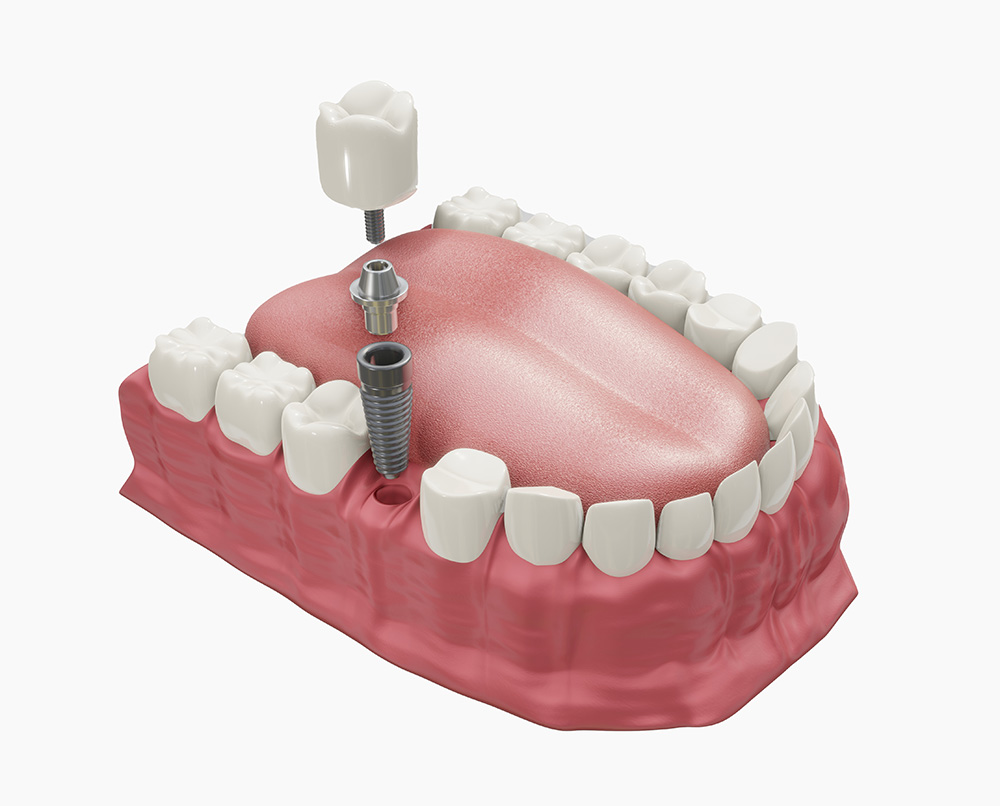Implant Placement

Nowadays, losing a tooth no longer means having to live without it for the rest of your life. Surgeons can replace a missing tooth by placing a specialized post, known as a dental implant, into the jawbone, onto which a ceramic tooth is then built.
Even patients with complex cases can receive help at our surgical center—for example, those who have suffered jawbone damage due to trauma and require bone grafting before an implant can be placed. A dental implant restores not only lost teeth but also a person’s appearance and confidence. Implant-based tooth replacement is the most advanced and natural method of dental restoration, offering greater durability compared to traditional bridge prosthetics.
Because implant placement is a complex procedure, success can only be ensured by highly qualified specialists in a clinic that meets all surgical standards. It is essential to avoid dental facilities where staff qualifications, equipment, and operating conditions do not meet the necessary requirements.

Nowadays, losing a tooth no longer means having to live without it for the rest of your life. Surgeons can replace a missing tooth by placing a specialized post, known as a dental implant, into the jawbone, onto which a ceramic tooth is then built.
Even patients with complex cases can receive help at our surgical center—for example, those who have suffered jawbone damage due to trauma and require bone grafting before an implant can be placed. A dental implant restores not only lost teeth but also a person’s appearance and confidence. Implant-based tooth replacement is the most advanced and natural method of dental restoration, offering greater durability compared to traditional bridge prosthetics.
Because implant placement is a complex procedure, success can only be ensured by highly qualified specialists in a clinic that meets all surgical standards. It is essential to avoid dental facilities where staff qualifications, equipment, and operating conditions do not meet the necessary requirements.
How are implants "grown" into the bone?
Modern implants are initially physically attached to the bone, but the key factor is how well the bone accepts the implant and how the process of osseointegration works. Research conducted by Per Brånemark and later by scientists at the University of Gothenburg showed that pure titanium implants integrated with the bone better than those made of titanium alloys. However, today, a widely used titanium, vanadium, and aluminum alloy—common in various medical applications—has been found to integrate with bone in a way similar to pure titanium.
Early implant posts had smooth surfaces, but modern implants are roughened using various techniques. This significantly increases the implant’s surface area, allowing the bone to attach more securely. However, a rough surface also provides a better environment for bacterial growth compared to a smooth one. Despite ongoing research, the relationship between an implant’s surface texture and bone integration is not yet fully understood. Additionally, each manufacturer keeps their production methods a closely guarded secret, meaning even specialists who place these implants may not always know the exact details of their composition.
For years, researchers have also been working on developing durable ceramic implants. Although ceramics integrate very well with bone, achieving sufficient physical strength remains a challenge.
How is a dental implant placed?
First, a hole is drilled into the jawbone using drills of different diameters. It is crucial that the drill moves slowly and receives sufficient cooling. Excessive heat during drilling can damage the bone and reduce its ability to integrate with the implant.
After drilling, the implant post is secured into the opening. Typically, it remains beneath the gum and begins to integrate with the bone. This process takes about six months for the upper jaw and three months for the lower jaw. The diameter of the implant post is chosen based on the patient’s jawbone characteristics, and its length can reach up to 1.7 cm.
Once the implant has fused with the bone, an abutment is attached, serving as the foundation for the dental crown. It is crucial that no gaps form between the abutment and the post, as bacteria could accumulate and cause infections. To prevent this, implant manufacturers have developed various solutions, such as using conical-shaped connections.
There are also one-piece implants, where the post remains exposed through the gum during the integration period. These are more challenging for surgeons to position accurately, but they eliminate potential issues with the post-abutment connection.
In normal conditions, male jawbones can exert a force of up to 574 Newtons, while female jawbones can exert up to 384 Newtons, or even more according to some studies. Without proper osseointegration, ensuring that an implant stays securely in place under such forces would be difficult.
If a patient’s bone is insufficient to support an implant post, various techniques can compensate for this. For example, the lower edge of the sinus cavity may be lifted and filled with artificial bone, or the patient’s own bone may be transplanted from another area.
(*Materials used from Tarkade Klubi magazine, published with the author’s permission.)
Book a Consultation Today
The first step in getting a dental implant is a thorough consultation with our specialist.
During the consultation, we assess your oral health, perform the necessary X-ray examinations, and discuss the best treatment options for you.
You will also get answers to all your questions, helping you make an informed decision.
Book your appointment today and take a step closer to a healthy, beautiful smile!